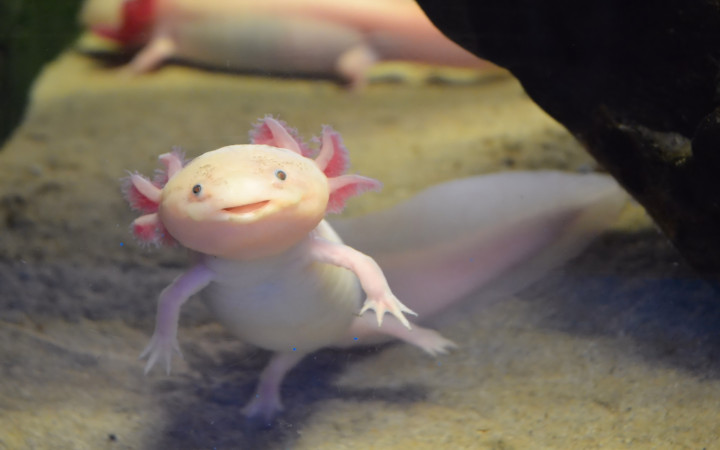Today’s Wonder of the Day was inspired by Norah from Glen Rock, NJ. Norah Wonders, “How does an axolotl regrow its limbs?” Thanks for WONDERing with us, Norah!
Have you ever wanted a puppy? They’re so cute and small and furry! Puppies are fun to play with. When you ask your family, they might say something like, “Puppies don’t stay puppies forever.” That’s true. Puppies grow up to be adult dogs. If you’re looking for a pet that WILL stay a baby forever, we’ve got an animal for you!
The axolotl (pronounced ACK-suh-LAH-tuhl), also known as the Mexican walking fish, is an amphibian that’s native to the waters near Mexico City. These creatures have a rare ability. They can stay in their larval state their entire lives. While other amphibians grow up and leave the water to live on dry land, most axolotls stay babies their entire lives.
Wait. If axolotls live their entire lives in water, then aren’t they fish? Some might think so, but that’s not true! In rare cases, axolotls will mature. These axolotls leave the water and live on land. Because of their ability to grow up and leave the water, experts classify axolotls as amphibians. When axolotls do grow up, we call them Mexican salamanders.
What do axolotls look like? Their name comes from an Aztec word meaning “water dog” or “water monster,” if that gives you any idea. Axolotls have long bodies, short legs, and tails. They have feathery external gills that ripple through the water when they move. Axolotls have four toes on their front feet and five toes on their back feet. They can grow to be a foot long.
Axolotls are also known for having wide mouths. Many appear to be permanently smiling. They can be a variety of colors. Typically, axolotls are brown or black. They often have spots of gold or olive. However, some axolotls are other colors, including white and gold.
Don’t axolotls sound cute? Many people think so. However, you may want to keep your distance if you see an axolotl in the wild. They are typically top predators in their habitats. While axolotls are not known to attack humans, they do eat worms, tadpoles, insects, and some fish.
Axolotls are especially aggressive toward each other. Two axolotls in the same area will attack one another, biting off gills, feet, and tails. But have no fear! Axolotls have another trick up their sleeves. They can regenerate many body parts. They can even regrow their own hearts and other organs.
Looking for an axolotl in the wild? You’ll have the best chance at night. Axolotls are nocturnal animals, meaning they avoid light. Like many nocturnal animals, they have poor eyesight. They rely on their other senses, mostly smell, to hunt.
However, you may have a very difficult time finding a wild axolotl. These amphibians have a very small habitat—they only live in a lake near Mexico City. As a result of human activity, much of their home has been destroyed. A 2013 study found no axolotls in the wild. This left many to believe they now live only as pets and in public aquariums. Today, experts consider axolotls critically endangered.
Many people find caring for axolotl pets is mostly easy. They aren’t very social and prefer to be left alone. Axolotls shouldn’t be picked up. Instead, they should stay in a large tank in a room away from bright sunlight. And be sure to never house two axolotls together!
Despite their aggression toward each other, many people like axolotls because of their friendly appearance. Their unique abilities to remain larval and regrow body parts also interest us. Would you like to have an axolotl as a pet? They’re much easier to care for than puppies are! Would you rather see axolotls return to the wild? How can we clean up their habitat?
Standards: NGSS.LS1.A, NGSS.LS2.C, NGSS.LS4.D, NGSS.ESS3.C, CCRA.L.1, CCRA.L.2, CCRA.L.3, CCRA.L.6, CCRA.R.1, CCRA.R.2, CCRA.R.10, CCRA.W.2, CCRA.W.3, CCRA.W.9, CCRA.SL.1, CCRA.SL.2




